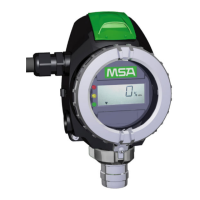Approvals
PrimaX
56
GB
- The relay contacts must be protected with a fuse rated 0.6 of the nominal spec-
ified relay contact current.
- The failure relay contacts must be safety related processed for warning purpos-
es when the 4 to 20 mA link is not use for the alarm condition.
- The tests of the 4-20 mA - output signal and alarm conditions and the test of the
alarm and fault relays, LEDs and display have to be done during every calibra-
tion phase.
- The connected controller has to monitor the 4-20 mA signal current for values
below 4 mA and above 20 mA.
- For the correct use of the combustible sensor a minimum oxygen concentration
of 10 Vol% is necessary.
- The presence of catalytic poisons has to be avoided for the combustible sensor.
- A functional check/calibration check has to be done for the complete system.
- A visual check has to be done monthly.
- A system check has to be done every year.
- For the test gas, the gas has to be used which is defined for the measurement.
The concentration of the test gas has to be in the middle of the measure range.
- For zero gas, synthetic air has to be used.
- An adjustment has to be done under the following conditions:
difference at zero > +/- 5 % UEG
difference at sensitivity > +/- 20 % of the rated value
- If the calibration is inside of the valid tolerance, the calibration interval can be
doubled.
- The maximum of the calibration interval is 16 weeks.
- The sensor has to be replaced if the sensor sensitivity during the operation is
reduced to less than 50 % of the initial sensitivity.
- After exposure of gas above the measuring range, the sensor has to be imme-
diately calibrated/adjusted, independent of the calibration interval. In the case
of an adjustment the sensitivity of the sensor has to be rechecked again after
24 hours.
- If the appearance of catalytic poisons for the combustible sensor can not be
avoided, the calibration interval has to be considerably reduced.

